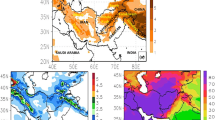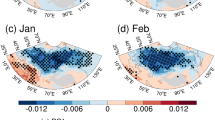Abstract
Interdecadal changes in the Asian winter monsoon (AWM) variability are investigated using three surface air temperature datasets for the 55-year period of 1958–2012 from (1) the National Centers for Environmental Prediction-National Center for Atmospheric Research reanalysis 1 (NCEP), (2) combined datasets from the European Centre for Medium-range Weather Forecasts (ECMWF) 40-yr reanalysis and interim data (ERA), and (3) Japanese 55-year reanalysis (JRA). Particular attention has been paid to the first four empirical orthogonal function (EOF) modes of the AWM temperature variability that together account for 64% of the total variance and have been previously identified as predictable modes. The four modes are characterized as follows: the first mode by a southern warming over the Indo-western Pacific Ocean associated with a gradually increasing basin-wide warming trend; the second mode by northern warming with the interdecadal change after the late 1980s; the third and fourth modes by north-south triple pattern, which reveal a phase shift after the late 1970s. The three reanalyses agree well with each other when producing the first three modes, but show large discrepancy in capturing both spatial and temporal characteristics of the fourth mode. It is therefore considered that the first three leading modes are more reliable than the rest higher modes. Considerable interdecadal changes are found mainly in the first two modes. While the first mode shows gradually decreasing variance, the second mode exhibits larger interannual variance during the recent decade. In addition, after the late 1970s, the first mode has a weakening relationship with the El Niño-Southern Oscillation (ENSO) whereas the second mode has strengthening association with the Artic Oscillation (AO). This indicates an increasing role of AO but decreasing role of ENSO on the AWM variability. A better understanding of the interdecadal change in the dominant modes would contribute toward advancing in seasonal prediction and the predictability of the AWM variability.
Similar content being viewed by others
References
Bao, Q., J. Yang, Y. Liu, G. Wu, and B. Wang, 2010a: Roles of anomalous Tibetan plateau warming on the severe 2008 winter Storm in centralsouthern China. Mon. Wea. Rev., 138, 2375–2384.
Chu, J.-E., and Coauthors, 2014: Future change of the Indian Ocean basinwide and dipole modes in the CMIP5. Clim. Dynam., 43, 535–551, doi:10.1007/s00382-013-2002-7.
Dee, D. P., and Coauthors, 2011: The ERA-Interim reanalysis: Configuration and performance of the data assimilation system. Quart. J. Roy. Meteor. Soc., 137, 553–597.
Ebita, A., and Coauthors, 2011: The Japanese 55-year reanalysis “JRA- 55”: An interim report. SOLA, 7, 149–152.
Gong, D.-Y., and C.-H. Ho, 2002: The Siberian high and climate change over middle to high latitude Asia. Theor. Appl. Climatol., 72, 1–9.
Gong, D.-Y., S.-W. Wang, and J.-H. Zhu, 2001: East Asian winter monsoon and Arctic Oscillation. Geophys. Res. Lett., 28, 2073–2076.
Guilyardi, E., and Coauthors, 2012: A first look at ENSO in CMIP5. CLIVAR Exchanges, 17, 29–32.
Ha, K.-J., K.-Y. Heo, S.-S. Lee, K.-S. Yun, and J.-G. Jhun, 2012: Variability in the East Asian monsoon: a review. Meteor. Appl., 19, 200–215.
He, S., and W. Wang, 2013: Oscillating relationship between the East Asian winter monsoon and ENSO. J. Climate, 26, 9819–9838.
He, S., H. Wang, and J. Liu, 2013: Changes in the relationship between ENSO and Asia-Pacific Midlatitude winter atmospheric circulation. J. Climate, 26, 3377–3393.
Jhun, J.-G., and E.-J. Lee, 2004: A new East Asian winter monsoon index and associated characteristics of winter monsoon. J. Climate, 17, 711–726.
Kalnay, E., and Coauthors, 1996: The NCEP/NCAR 40-year reanalysis project. Bull. Amer. Meteor. Soc., 77, 437–471.
Lee, J.-Y., and B. Wang, 2014: Future change of global monsoon in the CMIP5. Clim. Dynam., 42, 101–119.
Lee, J.-Y., S.-S. Lee, B. Wang, K.-J. Ha, and J.-G. Jhun, 2013a: Seasonal prediction and predictability of the Asian winter temperature variability. Clim. Dynam., 41, 573–587.
Lee, J.-Y., K.-H. Seo, J.-S. Kug, Y.-S. Choi, K. Yu, and K.-J. Ha, 2014: Future change of Northern Hemisphere summer tropicalextratropical teleconnection in CMIP5 models. J. Climate, 27, 3643–3664, doi:10.1175/JCLI-D-13-00261.1.
Lee, J.-Y., and Coauthors, 2010: How are seasonal prediction skills related to models’ performance on mean state and annual cycle?. Clim. Dynam., 35, 267–283.
Lee, S.-S., S.-H. Kim, J.-G. Jhun, K.-J. Ha, and Y.-W. Seo, 2013b: Robust warming over East Asia during the boreal winter monsoon and its possible causes. Environ. Res. Lett., 8, 034001.
Li, F., H. Wang, and Y. Gao, 2014: On the strengthened relationship between East Asian winter monsoon and Arctic Oscillation: A comparison of 1950–1970 and 1983–2012. J. Climate, in press, doi:http://dx.doi.org/10.1175/JCLI-D-13-00335.1.
North, G. R., T. L. Bell, R. F. Cahalan, and F. J. Moeng, 1982: Sampling errors in the estimation of empirical orthogonal functions. Mon. Wea. Rev., 110, 699–706.
Rayner, N. A., and Coauthors, 2003: Global analyses of sea surface temperature, sea ice, and night marine air temperature since the late nineteenth century. J. Geophys. Res., 108(D14), 4407, doi:10.1029/2002JD002670.
Sohn, S. J., C. Y., Tam, and C. K. Park, 2011: Leading modes of east Asian winter climate variability and their predictability: an assessment of the APCC multi-model ensemble. J. Meteor. Soc. Japan, 89, 455–474.
Uppala, S. M., and Coauthors, 2005: The ERA-40 re-analysis. Quart. J. Roy. Meteor. Soc., 131, 2961–3012.
Wang, B., J.-Y. Lee, and B. Xiang, 2014: Predictable mode analysis of Asian summer monsoon rainfall predictability. Clim. Dynam., doi:10.1007/s00382-014-2218-1.
Wang, B., Z. Wu, C.-P. Chang, J. Liu, J. Li, and T. Zhou, 2010: Another look at interannual-to-interdecadal variations of the East Asian winter monsoon: the Northern and Southern temperature modes. J. Climate, 23, 1495–1512.
Wang, H., S. He, and J. Liu, 2013: Present and future relationship between the East Asian winter monsoon and ENSO: Results of CMIP5. J. Geophys. Res., 118, 5222–5237.
Wang, L., W. Chen, and R. Huang, 2008: Interdecadal modulation of PDO on the impact of ENSO on the East Asian winter monsoon. Geophys. Res. Lett., 35, L20702.
Wang, L., R. Huang, L. Gu, W. Chen, and L. Kang, 2009: Interdecadal variations of the East Asian winter monsoon and their association with quasi-stationary planetary wave activity. J. Climate, 22, 4860–4872.
Watanabe, M., and T. Nitta, 1999: Decadal changes in the atmospheric circulation and associated surface climate variations in the northern Hemisphere winter. J. Climate, 12, 494–510.
Wei, K., and Q. Bao, 2012: Projections of the East Asian winter monsoon under the IPCC AR5 scenarios using a coupled model: IAP_FGOALS. Adv. Atm. Sci., 29, 1200–1213.
Wu, B., and J. Wang, 2002: Winter arctic oscillation, Siberian high and East Asian winter monsoon. Geophys. Res. Lett., 29, 18–7.
Wu, B., R. Zhang, and R. D’Arrigo, 2006: Distinct modes of the East Asian winter monsoon. Mon. Wea. Rev., 134, 2165–2179.
Yang, L. N., and B. Y. Wu, 2013: Interdecadal variations of the East Asian winter surface air temperature and possible causes. Chinese Sci. Bull., 58, 3969–3977.
Yeh, S.-W., Y.-J. Kang, Y. Noh, and A. J. Miller, 2011: The North Pacific climate transitions of the winters of 1976/77 and 1988/89. J. Climate, 24, 1170–1183.
Yun, K.-S., K.-H. Seo, and K.-J. Ha, 2010: Interdecadal change in the relationship between ENSO and the intraseasonal oscillation in East Asia. J. Climate, 23, 3599–3612.
Zhang R., A. Sumi, and M. Kimoto, 1996: Impact of El Niño on the East Asian monsoon: a diagnostic study of the ‘86/87 and ‘91/92 events. J. Meteor. Soc. Japan, 74, 49–62.
Author information
Authors and Affiliations
Corresponding author
Rights and permissions
About this article
Cite this article
Yun, KS., Seo, YW., Ha, KJ. et al. Interdecadal changes in the Asian winter monsoon variability and its relationship with ENSO and AO. Asia-Pacific J Atmos Sci 50, 531–540 (2014). https://doi.org/10.1007/s13143-014-0042-5
Received:
Accepted:
Published:
Issue Date:
DOI: https://doi.org/10.1007/s13143-014-0042-5




